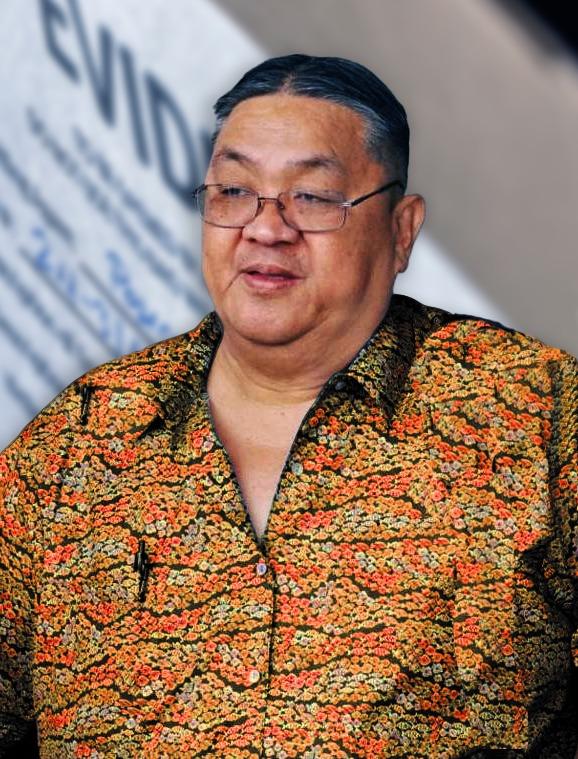Raymond and Juanita Martinez paid their dues to society – the maximum allowable 48 months in federal prison according to sentencing guidelines – for a crime the federal government is trying to punish them for again. This is according to their motion to dismiss a jury tampering indictment against them in the U.S. District Court of Guam on the grounds of “double jeopardy.”
The case, which has its origins in 2015 drug trafficking charges followed by two failed prosecutions in 2018, took several turns before ending up in a federal court in California, where the Martinezes ended up pleading guilty to a lesser charge. And according to the records from that California case, the federal government indeed used the jury tampering allegation in its sentencing arguments that led to the Martinezes’ imprisonment from late-2018 to 2022.
The double jeopardy reference comes from the Fifth Amendment of the U.S. Constitution, which states in part, “No person shall … be subject for the same offense to be twice put in jeopardy of life or limb.”
Basically, according to Cornell Law, the double jeopardy clause “prohibits anyone from being prosecuted twice for substantially the same crime.” It also means that once you’ve been punished for a certain crime, you cannot be punished for that same criminal incident ever again.

The Martinezes were charged in federal court in 2015 on allegations they conspired to bring meth into Guam from California. After a hung jury in early 2018, federal prosecutors retried the case in October that year. That resulted in another hung jury, this time with more jurors voting not guilty. However during the course of that case, a private investigator they hired – John “Boom” Mantanona – was under FBI investigation on a separate matter involving drug trafficking, police and public corruption. That case continues and has been under seal since Mr. Mantanona’s indictment in early 2019.
During the Mantanona investigation, according to federal court documents, wire tapped phone calls allegedly show he was engaged in a conspiracy to get a juror on the second Martinez trial to become the jury foreman and to vote “not guilty.” Transcripts of phone conversations between Mr. Mantanona and Mr. and Ms. Martinez (separately), show Mantanona discussing his knowledge of the actions of one of the jurors after the second trial had concluded.
The FBI brought the matter to the U.S. Attorney, who brought the matter before U.S. District Court of Guam chief judge Frances Tydingco-Gatewood. Ms. Tydingco-Gatewood ordered the dismissal of charges in Guam’s federal court in favor or prosecution of the Martinezes in federal court in California. She also ordered the Martinezes detained due to the allegations of jury tampering. They were detained through their extradition to California and into their federal prison sentence, which began after they pleaded guilty to lesser charges and were committed on July 29, 2019.
The two agreed to plead guilty to a lesser federal crime than the original charges they faced: essentially, using a telephone to further a drug trafficking conspiracy. They also agreed to serve the maximum applicable sentence: 48 months, though they could have instead left the sentence to the judge, who had the discretion to sentence them to between 12 months and 48 months in prison.
The Martinezes claim the reason they agreed to the maximum applicable prison sentence was the toll that their criminal defense was taking on them, and that they did not wish to go through another trial, this time involving the trafficking charges and the allegations of jury tampering. Had it not been clear to them from the government that their punishment ended the government’s pursuit of all the crimes alleged to that point, they never would have stipulated to the maximum applicable sentence, they claim.
They served their full sentence, which included the time since they were detained in Guam on suspicion of the jury tampering allegation, and they came back to Guam in 2022. They have since been gainfully employed, and according to the records of their probationary period, have been in compliance with their probation.
However, on October 19, 2022, federal prosecutors in Guam secured a Grand Jury indictment against the Martinezes for the same jury tampering allegation made in 2018. The case goes to trial in August, as both defendants assert their innocence.
This Friday, both sides of the case will argue whether the case should be dismissed for, among other things, double jeopardy prosecution.
“Pursuant to the April 11, 2019, California Plea Agreement and the record related thereto, Mr. Martinez understood the Plea Agreement resolved all outstanding issues, including the jury tampering allegations,” the attorneys for Mr. Martinez wrote in his May 1 motion to dismiss on double jeopardy grounds. According to the motion, the California Plea Agreement “specifically provided that additional promises, understandings, and agreements may be entered into ‘on the record in court.'”
Not only was the jury tampering allegation addressed in every California court proceeding leading up to the sentencing of the Martinezes, according to the motion, the full resolution was agreed upon by Guam’s federal prosecutors and then adopted by the California federal prosecutor.
Guam federal prosecutor Rosetta San Nicolas in her opposition to the motion to dismiss replied on May 6, arguing that federal law requires the court to view the California plea agreement as a contract, where courts apply contract principles, including the enforcement of a contract’s “plain language … if it is clear and unambiguous on its face.”
Ms. San Nicolas referred to the plea agreement itself, which states in part that “no additional promise, understanding or agreement may be entered into unless in a writing signed by all parties or on the record in court.”
It is that last part of the sentence, “on the record in court,” that the Martinezes refer to in their arguments.
“The jury tampering allegations were made a part of the prior Guam and California proceedings and prior to agreeing to plead guilty in the California Plea Agreement, Mr. Martinez wanted to ensure that pleading guilty would dispose of the allegations against him with finality,” the defense argued in its double jeopardy dismissal motion.
Ms. San Nicolas, in her opposition, pointed to the series of questions asked by the court to the Martinezes at their change of plea hearing that resulted in their 48-month prison sentence, and included portions of the transcript where the judge asked in what’s known as the Rule 11 Colloquy whether prosecutors made any other promises. Ms. San Nicolas asserted that the Martinezes’ attorneys should have, at that point, specified the jury tampering issue.
However, Mr. Martinez’s attorney pointed out a part of the transcript Ms. San Nicolas did not include, where the judge in California said, “…the Court considers other factors that might result in either a higher or a lower sentence than the sentence suggested by the guideline range.” This was prior to all parties agreeing to the maximum applicable sentence of 48 months that, according to the Martinezes they believed satisfied all the allegations made against them to that point.
Kandit reviewed the California case, which showed multiple instances of the jury tampering allegations during the period of the extradition all the way to their July 29, 2019 sentencing. The jury tampering allegations were made part of the Guam proceedings, and at the Martinezes’ initial appearance in California where they already were detained, at a motion for bail review.
“Jury tampering was an issue in, referenced in and adjudicated in the California Case Criminal Minutes,” according to the Martinez motion to dismiss on double jeopardy grounds. “The Government’s combined Sentencing Position for Defendants Raymond John Martinez and Juanita Martinez made an issue of, argued, and litigated jury tampering in support of its sentencing position and disposition of the Guam and California cases.”
That June 20, 2019 sentencing report by federal prosecutors in California appears pivotal to the Martinez argument that the defendants already served prison time for the allegations.
In its memorandum of points and authorities that the Martinezes later stipulated to, federal prosecutors said the Martinezes were “two drug dealers who tried to smuggle methamphetamine into Guam, got caught, and then engaged in jury tampering to avoid responsibility for their actions … In their plea agreements, defendants agreed to recommend, and to refrain from seeking any sentence below, a Guideline-recommended statutory maximum sentence of 48 months’ imprisonment.”
In its statement of facts, the district attorney’s office wrote, “During the second trial, defendants ‘were aware of and/or participated in an attempt to obstruct justice . . . through efforts to improperly contact and influence a juror.”
Right before concluding the argument, the federal prosecutor made the jury tampering allegation’s weight on sentencing abundantly clear: “Defendants’ attempt to escape the consequences of their actions by influencing jurors further supports imposition of a 48-month sentence. During bail review proceedings, this Court reviewed evidence provided by the government and concluded that defendants ‘were aware of and/or participated in an attempt to obstruct justice . . . through efforts to improperly contact and influence a juror. (Dkt. 61 at 4.) Defendants’ efforts to impede the administration of justice only compounded the seriousness of their criminal conduct. Under the circumstances, the statutory maximum sentence recommended by the Guidelines and the parties is amply justified.”
The Martinez dismissal motion reminds the court that Mr. Martinez argued with prosecutors about the jury tampering language because he knew the allegations would weigh on his sentencing. In a response to the government’s sentencing brief in 2019, he wrote “Juror issue – the government forgets that in the second trial, four other jurors voted not guilty, in recognition of the failures of the government’s case.”
According to the Martinez motion, “When the Court sentenced Mr. Martinez after considering the entire court record, the punishment imposed encompassed the jury tampering allegations.”
At sentencing on July 25, 2019, U.S. District Court Judge Fernando Olguin said at the outset, “I have read and considered the following documents: The presentence report filed on June 17, 2019, the Government’s sentencing papers filed on June 20, 2019, and defendant’s sentencing papers filed on July 3, 2019.”
The focus of the judge’s questioning of attorneys on both sides focused on whether both sides fully comprehended the sentencing papers, which included the recommendation of the 48 month prison sentence that included the jury tampering allegation.
Judge Olguin accepted the sentencing reports and sentenced the Martinezes to 48 months in prison “Based on the plea agreement and the record before the Court,” he said at sentencing.









